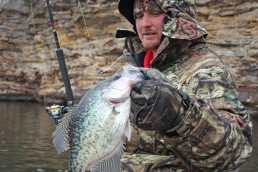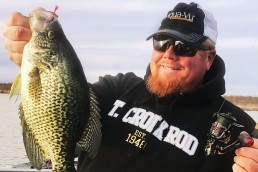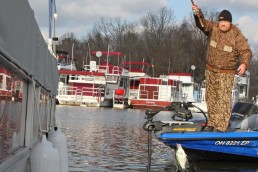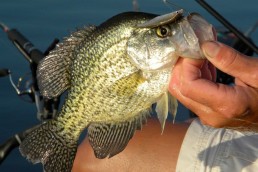Soft-water Christmas Crappies
SHARE THIS POST
The southern part of the MidWest Outdoors region will have open water in mild and normal winters. Kentucky Lake, KY-TN is one example of a good fishing opportunity that should be free of ice in December. Lakes slightly to the north of Kentucky Lake may occasionally ice-over in bays, but remain mostly open during winter.
Proper winter strategies can provide a lot of tugs on the line, and a livewell full of good-tasting crappies. The following are two proven tactics that help ensure success.
Deep vertical jigging
Illinois fishing guide and two-time Crappie Classic Champ, Kyle Schoenherr (618-314-2967) says he likes to vertical jig deep water in the winter. Kinkaid Lake is a favorite spot. He says that December includes cold weather, but the water usually remains good for boat launching and fishing.
He keeps his setup simple, but each item is very important. He uses a 12-foot B’n’M jigging pole rigged with a small spinning reel. The long pole keeps baits away from the boat—an important step even when fishing deep water, especially when it’s clear. The pole tip is sensitive, so it will show light bites. The line is 15-pound-test high-visibility braid for strength and sensitivity. The leader is 12-pound-test monofilament that is strong and less visible than braid. A #2 gold Aberdeen hook is placed on a short loop about 12 to 18 inches above a bell sinker. The sinker is 3/8- to 1-ounce depending upon the depth, wind and current.
“We fish anywhere from 30 to 60 feet in winter,” says Schoenherr. “The rig is dropped to the bottom, then lifted up until the line is tight, but the sinker is still on bottom. Fish often hit the bait right on bottom. When moving the bait, lift the sinker off bottom and move it, then drop back down.
“Bites are usually so light and easy, we don’t always feel them. The pole tip is raised up, and it’s just a dead weight, but that’s a fish. Set the hook as soon as a bite is recognized. On a good day, the crappies sometimes make it easy, and just drill it. If you feel a little ‘tick’ or a good bite, set the hook immediately. This is simple fishing, but very effective.”
Schoenherr hooks his minnow in the back part of the eyes. He believes a minnow is damaged less, so it lives longer and swims better, helping to draw more strikes.
Are you enjoying this post?
You can be among the first to get the latest info on where to go, what to use and how to use it!
“The high-vis braided line is easier to see, and it doesn’t stretch, so we detect more bites. The strength helps to get out of the brush without breaking off. This technique is simple and affordable. Anyone can do it.”
Casting slip-floats
Stumps in 15 to 30 feet of water are good targets in most waters. Find a few on a drop-off, and the stumps become prime targets.
A graph is important for finding the right spot. After pinpointing the spot with electronics, mark it with a waypoint and/or a marker buoy. Boat position is important, and should allow baits to drift with wind or current to the target area.
A casting rig can be any light-to-medium spinning rig. A long 8- or 9-foot pole makes casting easier, since softly lobbing a minnow is required. A #2 hook, split-shot sinkers and a slip-float completes the rig. The float should be just big enough to float the rig, yet offer little resistance if a fish pulls it under.
Adjust a bobber stop to set the float to the right depth. If fish are on stumps in 18 feet of water, try setting the float to 16 feet, or to the height of the stumps. Cast upwind or up-current from the spot. Allow a natural presentation by letting it float into the prime zone.
Watch for bites. It may be a simple lift of the float, a movement sideways or a pull down. Take up slack line, reel fast and sweep the rod back. When the float is away from the boat 20 feet or more, the angle of the line requires a lot of line to be taken up before it’s straight enough to put pressure on the hook. A longer pole helps when setting the hook, because the sweep of an 8-foot pole is more than with a short 5- or 6-foot pole.
Simple presentations can reward fishermen with good Christmas gifts. Experts say super-slow presentations are critical for success when fishing deep. However, techniques are simple and easy. Dress warmly, be safe and enjoy pulling in some healthy winter crappies.
MWO
SHARE THIS POST
Did you enjoy this post?
You can be among the first to get the latest info on where to go, what to use and how to use it!
Tim Huffman
Tim Huffman specializes in crappie fishing, is editor for two crappie magazines, as well as writing for several others. In 2018, he published his sixth book, Limiting Out for Crappie, available at Amazon. His first article appeared in MidWest Outdoors in 1988.



